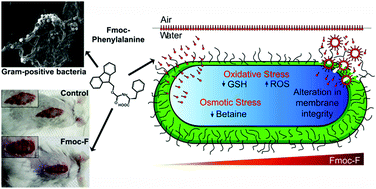当前位置:
X-MOL 学术
›
Soft Matter
›
论文详情
Our official English website, www.x-mol.net, welcomes your
feedback! (Note: you will need to create a separate account there.)
Fmoc-phenylalanine displays antibacterial activity against Gram-positive bacteria in gel and solution phases†
Soft Matter ( IF 2.9 ) Pub Date : 2018-02-24 00:00:00 , DOI: 10.1039/c7sm02317k Avinash Y. Gahane 1, 2, 3, 4 , Pritish Ranjan 1, 2, 3, 4 , Virender Singh 1, 2, 3, 4 , Raj K. Sharma 4, 5, 6, 7 , Neeraj Sinha 4, 5, 6, 7 , Mandeep Sharma 4, 8, 9, 10 , Rama Chaudhry 4, 11 , Ashwani K. Thakur 1, 2, 3, 4
Soft Matter ( IF 2.9 ) Pub Date : 2018-02-24 00:00:00 , DOI: 10.1039/c7sm02317k Avinash Y. Gahane 1, 2, 3, 4 , Pritish Ranjan 1, 2, 3, 4 , Virender Singh 1, 2, 3, 4 , Raj K. Sharma 4, 5, 6, 7 , Neeraj Sinha 4, 5, 6, 7 , Mandeep Sharma 4, 8, 9, 10 , Rama Chaudhry 4, 11 , Ashwani K. Thakur 1, 2, 3, 4
Affiliation

|
In the quest for new antimicrobial materials, hydrogels of Fmoc-protected peptides and amino acids have gained momentum due to their ease of synthesis and cost effectiveness; however, their repertoire is currently limited, and the mechanistic details of their function are not well understood. Herein, we report the antibacterial activity of the hydrogel and solution phases of Fmoc-phenylalanine (Fmoc-F) against a variety of Gram-positive bacteria including methicillin-resistant Staphylococcus aureus (MRSA). Fmoc-F, a small molecule hydrogelator, reduces the bacterial load both in vitro and in the skin wound infections of mice. The antibacterial activity of Fmoc-F is predominantly due to its release from the hydrogel. Fmoc-F shows surfactant-like properties with critical micelle concentration nearly equivalent to its minimum bactericidal concentration. Similar to Fmoc-F, some Fmoc-conjugated amino acids (Fmoc-AA) have also shown antibacterial effects that are linearly correlated with their surfactant properties. At low concentrations, where Fmoc-F does not form micelles, it inhibits bacterial growth by entering the cell and reducing the glutathione levels. However, at higher concentrations, Fmoc-F triggers oxidative and osmotic stress and, alters the membrane permeabilization and integrity, which kills Gram-positive bacteria. Herein, we proposed the use of the Fmoc-F hydrogel and its solution for several biomedical applications. This study will open up new avenues to enhance the repertoire of Fmoc-AA to act as antimicrobial agents and improve their structure–activity relationship.
中文翻译:

Fmoc-苯丙氨酸在凝胶相和溶液相中均显示出对革兰氏阳性细菌的抗菌活性†
在寻找新的抗菌材料时,Fmoc保护的肽和氨基酸的水凝胶由于易于合成和具有成本效益而获得了发展。但是,它们的功能目前有限,并且对其功能的机械细节还不太了解。本文中,我们报道了Fmoc-苯丙氨酸(Fmoc-F)的水凝胶和溶液相对多种革兰氏阳性细菌(包括耐甲氧西林的金黄色葡萄球菌(MRSA))的抗菌活性。Fmoc-F,一种小分子水凝胶剂,可在体外降低细菌负荷以及老鼠的皮肤伤口感染。Fmoc-F的抗菌活性主要是由于它从水凝胶中释放出来的。Fmoc-F表现出类似表面活性剂的特性,其临界胶束浓度几乎等于其最小杀菌浓度。与Fmoc-F相似,一些Fmoc共轭氨基酸(Fmoc-AA)也显示出与其表面活性剂特性线性相关的抗菌作用。在低浓度下,Fmoc-F不会形成胶束,它通过进入细胞并降低谷胱甘肽水平来抑制细菌生长。但是,在较高的浓度下,Fmoc-F会触发氧化和渗透压力,并改变膜的通透性和完整性,从而杀死革兰氏阳性细菌。在本文中,我们提出了Fmoc-F水凝胶及其溶液在几种生物医学应用中的用途。
更新日期:2018-02-24
中文翻译:

Fmoc-苯丙氨酸在凝胶相和溶液相中均显示出对革兰氏阳性细菌的抗菌活性†
在寻找新的抗菌材料时,Fmoc保护的肽和氨基酸的水凝胶由于易于合成和具有成本效益而获得了发展。但是,它们的功能目前有限,并且对其功能的机械细节还不太了解。本文中,我们报道了Fmoc-苯丙氨酸(Fmoc-F)的水凝胶和溶液相对多种革兰氏阳性细菌(包括耐甲氧西林的金黄色葡萄球菌(MRSA))的抗菌活性。Fmoc-F,一种小分子水凝胶剂,可在体外降低细菌负荷以及老鼠的皮肤伤口感染。Fmoc-F的抗菌活性主要是由于它从水凝胶中释放出来的。Fmoc-F表现出类似表面活性剂的特性,其临界胶束浓度几乎等于其最小杀菌浓度。与Fmoc-F相似,一些Fmoc共轭氨基酸(Fmoc-AA)也显示出与其表面活性剂特性线性相关的抗菌作用。在低浓度下,Fmoc-F不会形成胶束,它通过进入细胞并降低谷胱甘肽水平来抑制细菌生长。但是,在较高的浓度下,Fmoc-F会触发氧化和渗透压力,并改变膜的通透性和完整性,从而杀死革兰氏阳性细菌。在本文中,我们提出了Fmoc-F水凝胶及其溶液在几种生物医学应用中的用途。











































 京公网安备 11010802027423号
京公网安备 11010802027423号